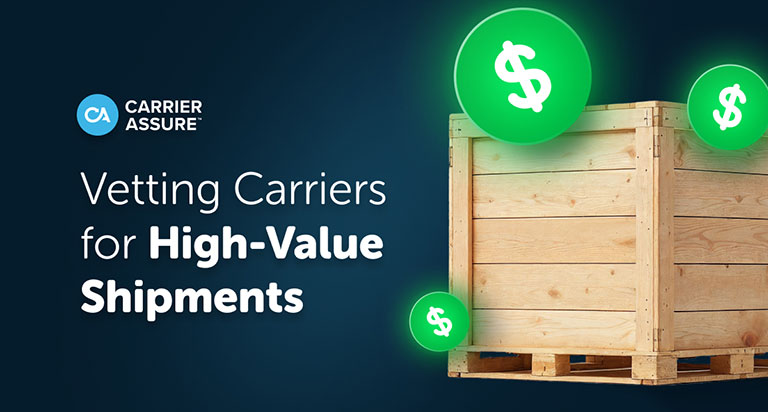Moving high-value freight is a different ballgame. We’re talking loads worth six figures or more: electronics, metals, luxury goods, even baby formula.
Trucking companies handling high-value freight must be vetted at a higher standard and held to higher expectations. At the end of the day, customers are trusting their logistics partners to make the right call, and a single bad choice can put that trust at risk.

The reward for thieves is huge, and they know exactly how to find weak spots. In fact, many scams start with carriers that have clean paperwork but no real activity, or worse, they’re part of a larger fraud network.
One wrong booking can wipe out profit, damage your client relationship, and leave you holding the bag with your insurance provider.
That’s why you need a clear, step-by-step process for carrier vetting before you hand over that load. Here’s how to do it, even if you’re not leveraging Carrier Assure, the platform built for carrier vetting.
Stage 1: Before You Even Consider Booking a Trucking Company
Think of it as your first and MUST follow-steps. You’re trying to spot obvious risk factors before you even assign a carrier to a shipment.
Watch out for:
- Contact information mismatches: Always compare what they give you with official records on SAFER or Carrier Assure. If it’s different, it could mean they’ve spoofed a legitimate carrier’s identity.
- Fleet size vs. inspections: If the trucking company claims 20 trucks but have only had 2 inspections in the past year, that gap needs explaining.
- Route and inspection patterns: If their history shows Midwest inspections but they’re suddenly bidding on a California-to-Florida lane, that’s a red flag
- Dispatcher behavior: Pushy, overly eager dispatchers trying to “lock it in” can signal desperation, or a ticking clock on a scam.
- Rates too low: A rate far below market is 100% bait.
The faster you weed out bad actors, the fewer chances they have to touch your freight.
Stage 2: Once You’ve Booked a Carrier
Now you’ve got a potential match. This is where surface-level carrier vetting isn’t enough, you need to validate EVERY operational detail.
Ask the carrier directly:
- Truck parking address: Verify it exists and is an actual yard, not a strip mall or empty lot.
- Equipment matches: Repeat names or matches on Carrier Assure can flag related entities, some of which may have poor performance or fraud history.
- Driver’s full name and cell number: Get this early. If they won’t provide it, that’s a problem.
- VIN of the truck: Verify it. Confirm it matches the year, make, and model they gave you.
- Additional phone numbers: Having more than one contact line makes spoofing harder.
Call the insurance broker and ask for:
- List of VINs: If it’s a scheduled VIN policy, make sure the truck they’re using is on it.
- Policy exclusions: This is where many brokers get blindsided. High-value commodities like electronics, alcohol, supplements, copper, and more are often excluded.
- Broker verification: Verify their name, address, and phone. If it’s a fake, you’ll often find mismatches or nonexistent listings.
A surprising number of scams are exposed at this stage, once the questions get specific. If the carrier hesitates, can’t produce documentation, or gives inconsistent answers, you just saved yourself a MASSIVE loss.
Stage 3: Check References & Research Further
Even if everything checks out so far, please don’t skip the reputation check.
- Call references: Ask if they’ve had safety issues, how many shipments they’ve completed, and when.
- Check the state’s corporate commission: Confirm they’re registered and in good standing.Trucking companies that survive the first two stages but fail here are often skilled impersonators. A quick reference call or corporate search can stop them cold.
Stage 4: Before Pickup
This is the final check point and the last chance to confirm you’re giving the load to the right trucking company.
- Call the driver before pickup: Confirm their name, truck number, and details match what you have on file.
- Confirm DOT/MC on the truck door: This is your “two-factor authentication” for carrier identity.
- Tender just one shipment first: Never hand over multiple high-value loads to a new carrier on day one.
- Wait for POD and verify all details before giving more work.
Most last-minute thefts happen right here. If something feels off on pickup day, stop the load …. you’ll never regret a delay as much as you’ll regret a loss.
Stage 5: Communication Over Everything
- Avoid relying solely on email: Scammers hide behind text. Pick up the phone, ask questions, and listen for hesitation or inconsistent details.
High-value freight should never move without higher-level carrier vetting, and carriers that want to haul it should meet those standards without hesitation. By layering these checks, you make yourself a much harder target and drastically cut your chances of becoming the next cautionary tale in freight fraud.
Carrier Assure Helps You Vet Carriers Faster
Everything above takes time, and in high-value freight, speed matters.
With Carrier Assure, you can instantly spot red flags like mismatched contact information, related entities, and unusual inspection patterns, while also checking real-time performance data to see if a trucking company is truly active or just looks good on paper.
The Carrier Assure software platform helps you identify connections between carriers that may share equipment or contact details with risky operators and lets you review insurance details and broker information in one place.
Instead of chasing down details across multiple sources, Carrier Assure puts the most critical intelligence right in front of you.
Book a demo today and protect your next high-value load.






